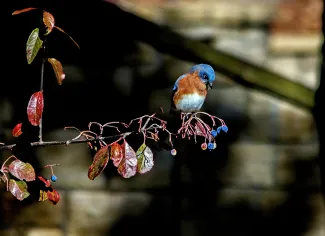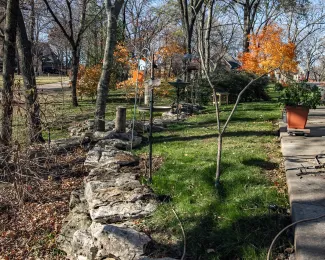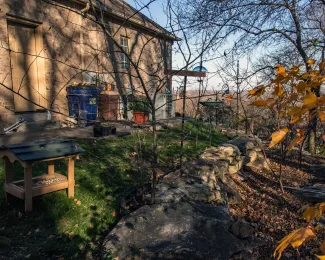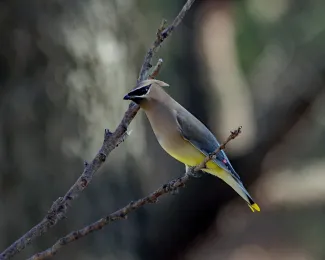A passion for the outdoors can lead nature enthusiasts down an incredible and well-traveled path, but it also comes with the freedom to combine interests and blaze new trails.
In a story familiar to many outdoor enthusiasts, Terry Brunholtz's passion for the outdoors was sparked in childhood by an interest in anything "wildlife." And like many, the Owasso man's passion has grown and taken different shapes through the years, eventually leading to new outdoor passions. Brunholtz has since blended his initial interest in wildlife with equally strong interests in native landscaping and nature photography.
Years of intentional landscaping, driven by his love of birds and other wildlife, have transformed Brunholtz's northeastern Oklahoma backyard into a living nature photography set.
"I've always been interested in wildlife, but between getting established and getting my job going, I got so busy with life that it didn't occur to me that I could do something like this."
Creating a Nature Photography Set - Step One
Landscaping is for the birds ... and butterflies and foxes.
Brunholtz, now retired, first ventured down the path of creating wildlife habitat more than 20 years ago with a single bluebird box. Shortly after watching the first batch of bluebirds fledge, he and his wife broke ground for a new home on a one-acre lot in Owasso.
The new construction offered a fresh canvas for landscaping, and Brunholtz worked with the builders to leave as many mature trees as possible, and to build a natural retaining wall using the boulders unearthed while creating the house's walk-out basement.
"I had a one-acre tract of land. I was working full time and knew I couldn't spend hours and hours in the yard working on flowerbeds; it would just be too much to maintain. So, I thought, 'Why not plant in natives? Hopefully they can take care of themselves.'"

Eastern bluebird.
With the plan to incorporate native plants into his landscape, Brunholtz then connected his newfound interest in native landscaping to his initial love of wildlife with a question.
"If I could attract eastern bluebirds at my old house, what else could I attract on my new property?"
The resulting research started with "What can I expect to attract" and quickly led to the follow-up questions of "What can I plant to attract those species," and "Which of those plants can I expect to grow in my region and in my backyard."
From there, Brunholtz focused on adding native understory trees and shrubs and flowering plants to his backyard to benefit wildlife.
"I was really focused on adding habitat on all levels. Not all birds like tall trees. Some prefer smaller shrubs, and others live on the ground."
Brunholtz started small some 20 years ago and has simply kept adding to his landscape through the years.
"I've tried to design the landscape so that something is blooming or fruiting, or somehow benefiting wildlife in every season of the year. It's an ongoing process."
For inspiration, Brunholtz and his wife attend the Tulsa Audubon Society's annual Wildlife Habitat Garden Tour and Native Plant Sale.
"I've never missed it in 20 years and have gotten to know several of the native plant vendors. They work so hard and are so helpful and knowledgeable. They offer a lot of the same great native plants each year but will occasionally have something new. That's the highlight of my year for inspiration."
Though Brunholtz is still finding inspiration for his backyard, he thoroughly enjoys seeing birds, insects and other wildlife visit his backyard and its native plants.
"We have a red buckeye tree that is about 12- to 15-foot tall and about that wide. It blooms early in the spring with huge trumpet-like red and yellow flowers. It's just stunning – people will even stop along our street to see it in bloom. And we can always count on seeing newly arrived hummingbirds in the yard when it's in bloom.
"We've created a nature sanctuary in our backyard. If we want to see birds or wildlife, or spend time in nature, we don't have to go anywhere. We can just step out in our yard."
Creating a Nature Photography Set – Step Two
Make use of what you have ... and always carry a camera.
As Brunholtz's native landscaping became more established, he picked up yet another new interest of nature photography to record and document the wildlife that visited his yard.
"I've chased birds around the yard taking photos for several years, but it wasn't until a few years ago that I got the idea to create a photo blind of sorts from another member of the Nature Photographer's Network. As soon as he described his blind, I thought, 'I should have thought of that.'"
Brunholtz took stock of his options for creating a photography set and decided to build it in a previously identified project area using many materials he already had.
"Our house is built on an incline, and I had wanted to do something with the sloped area on the south side of the house for a while. I decided to terrace the slope with native stone, and planted shrubs on the lower level and put bird feeders and baths on the upper level. I shoot photographs from the side door of the garage and use the house as a blind.


Brunholtz has created a living nature photography set using many materials he had on hand. He often shoots photographs from the side door of his garage.
"I don't have the most expensive camera equipment, so I have to bring the birds in closer to get the shot I'm after. My blind has paid off tenfold."
Birds, butterflies, and other wildlife are drawn to the photography set thanks to the landscaping, feeders, and moving water of the bird baths.
To create more natural perches for his photographs than the feeders or fountains, Brunholtz has added small twigs to a post and has brought in a stump from a hazard tree he had removed from the yard. In addition to the woodpeckers he was hopeful to have visit the stump, several species, including an indigo bunting, have been photographed while eating seeds on the repurposed stump. Portable containers of salvia have also made their way onto the set and are moved to different locations depending on the lighting and conditions.

Small branches have been added to Brunholtz's living photography set to serve as natural perches for birds, including this cedar waxwing.
Now Brunholtz tries to never go outside without a camera. And he's always thinking of ways to improve his nature photography set.
"There's always something. In the 20 years, I've never lost my excitement."
